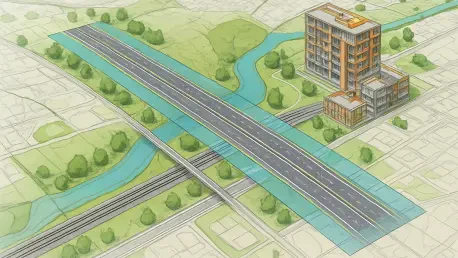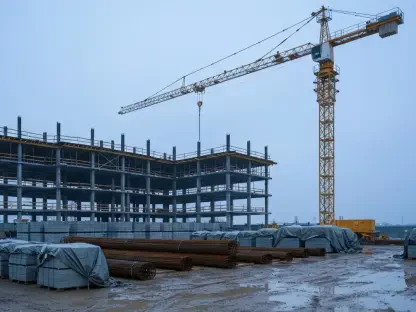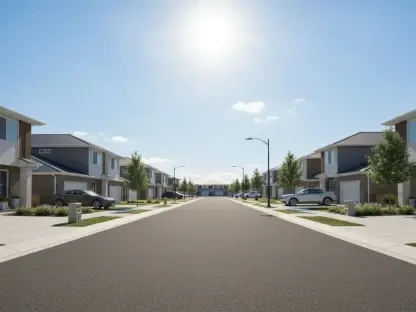In the sprawling world of infrastructure development, corridor mapping projects stand as monumental tasks, often stretching across hundreds of miles to chart roads, railways, pipelines, and power lines with precision. These endeavors produce staggering volumes of data, from lidar scans capturing intricate terrain details to high-resolution imagery and GNSS data ensuring accurate georeferencing. Managing such complexity is no small feat, and it demands cutting-edge tools to transform raw information into actionable strategies for planning, designing, and maintaining vital infrastructure. Enter Geographic Information Systems (GIS) and Building Information Modeling (BIM), two powerhouse technologies that form a dynamic partnership. Together, they bridge the gap between broad geospatial analysis and detailed engineering design, offering a comprehensive solution to the challenges of linear infrastructure projects. Their synergy not only streamlines workflows but also ensures that every phase of a project is grounded in reliable, data-driven insights.
Unveiling the Strengths of Geospatial and Design Tools
Mapping the Big Picture with GIS
Corridor mapping projects, by their very nature, encompass vast landscapes where understanding the geographic context is paramount to success. GIS emerges as the foundational technology in this realm, equipped to handle spatial data with unparalleled efficiency. It enables professionals to visualize expansive terrains, conduct environmental impact assessments, and plan right-of-way corridors with a clear grasp of land use patterns. Beyond mere visualization, GIS facilitates asset inventory management and detects changes over time, providing a dynamic view of how a corridor evolves. This capability is critical for identifying potential obstacles, such as encroaching vegetation or shifting soil conditions, long before they become costly problems. By integrating diverse datasets into a cohesive framework, GIS ensures that planners can make informed decisions that account for both immediate needs and long-term sustainability, setting a robust stage for infrastructure development across sprawling distances.
The significance of GIS extends into its ability to support collaborative planning across multiple stakeholders involved in corridor projects. With its advanced analytical tools, GIS can highlight areas of concern, such as environmentally sensitive zones or residential conflicts, allowing for proactive mitigation strategies. This geospatial backbone also aids in optimizing routes by factoring in topographic challenges and existing infrastructure, reducing the risk of unforeseen complications during construction. Moreover, GIS platforms often integrate real-time data feeds, ensuring that the information remains current as projects progress through various stages. This adaptability is essential in corridor mapping, where conditions can change rapidly over hundreds of miles. By providing a bird’s-eye view of the entire project landscape, GIS empowers teams to align their efforts with both regulatory requirements and community needs, fostering a balance between development goals and environmental stewardship.
Detailing Infrastructure with BIM Precision
While GIS excels in painting the broader geographic picture, BIM steps into the spotlight when it comes to the intricate details of infrastructure design and construction. BIM specializes in object-level modeling, allowing for the creation of highly detailed digital representations of specific components like power line towers, railway tracks, or substations. This precision is invaluable during the design phase, where exact specifications can mean the difference between a structure’s longevity and early failure. BIM also supports simulations that predict how these components will perform under various conditions, offering insights into potential maintenance needs before ground is even broken. By focusing on the minutiae of engineering, BIM ensures that every element of a corridor project is meticulously planned, reducing errors and enhancing safety standards across the board.
Beyond design, BIM plays a pivotal role in the construction and operational phases of corridor projects, ensuring seamless integration with the broader spatial data managed by GIS. Its ability to model individual assets in three dimensions allows contractors to visualize how each piece fits into the larger infrastructure puzzle, minimizing costly rework. Additionally, BIM’s data-rich models provide a repository of information that can be accessed throughout a project’s lifecycle, from initial construction to long-term maintenance. This detailed documentation supports asset management by tracking wear and tear on specific components, enabling predictive maintenance that extends infrastructure lifespan. The precision of BIM, when paired with the expansive scope of GIS, creates a powerful synergy that addresses both macro and micro aspects of corridor mapping, ensuring that projects are not only completed on time but also built to withstand the test of time.
Practical Synergy and Challenges in Implementation
Harnessing Combined Power for Project Success
The true potential of GIS and BIM unfolds when their capabilities are integrated, as demonstrated in a hypothetical scenario involving a utility company tasked with mapping a 200-mile power line corridor. In this case, aerial lidar and high-resolution imagery are gathered to capture detailed data on terrain, vegetation, and existing infrastructure. GIS platforms process this information to analyze land use patterns, identify potential conflicts with environmental or residential areas, and determine the most strategic locations for tower placements. This initial phase of geospatial analysis lays a critical foundation, ensuring that planners have a comprehensive understanding of the corridor’s challenges and opportunities. By leveraging GIS, the project team can make data-driven decisions that optimize routing and minimize disruptions, setting the stage for a smoother transition into design and construction phases.
Once the geospatial framework is established, BIM takes the baton to focus on the detailed engineering of infrastructure components within the corridor. Using the insights provided by GIS, engineers model individual elements such as power line towers and substations with exact specifications, ensuring structural integrity and compliance with standards. The integration of GIS and BIM datasets results in a unified digital representation of the entire project, facilitating seamless coordination among planners, designers, and contractors. This comprehensive model not only aids in visualizing how each component fits within the broader landscape but also supports long-term asset management by providing a detailed record of every element. The combined approach reduces the likelihood of errors during construction and enhances efficiency, proving that the partnership between GIS and BIM is a game-changer for delivering complex linear infrastructure projects on time and within budget.
Navigating Obstacles in Workflow Integration
Despite the clear advantages of combining GIS and BIM, integrating these systems presents notable challenges that must be addressed for optimal results. One significant hurdle is managing the immense volume of data generated by corridor mapping projects, which requires careful storage and formatting to ensure compatibility between GIS and BIM platforms. Without standardized data protocols, discrepancies can arise, leading to delays or inaccuracies in project planning. Additionally, the technical demands of maintaining data integrity across systems necessitate robust infrastructure and skilled personnel who can navigate both technologies. Addressing these issues involves investing in advanced data management solutions and training programs to equip teams with the tools needed to handle massive datasets effectively, ensuring that the integration process enhances rather than hinders project outcomes.
Another barrier lies in the organizational silos that often separate GIS and BIM teams within companies, impeding collaboration and slowing down workflows. Historically, these disciplines have operated independently, with geospatial experts focusing on broad landscape analysis and engineering teams concentrating on detailed design. Breaking down these barriers requires a cultural shift toward teamwork, supported by cross-training initiatives that familiarize staff with both GIS and BIM principles. Such efforts foster a shared understanding of project goals and encourage communication across departments, ultimately leading to more cohesive project execution. By prioritizing collaboration and investing in professional development, organizations can overcome these challenges, unlocking the full potential of GIS and BIM to deliver safer, more durable infrastructure that meets the demands of modern corridor mapping projects.
Reflecting on a Path Forward for Infrastructure Excellence
Building on Past Successes
Looking back, the integration of GIS and BIM in corridor mapping projects proved to be a transformative force in how infrastructure was planned and executed. Their combined ability to manage vast datasets and provide both expansive geographic insights and detailed engineering precision reshaped the landscape of linear projects. Historical challenges, such as data incompatibility and departmental silos, were met with innovative solutions like cross-training and advanced data management systems, paving the way for more streamlined workflows. Reflecting on these achievements, it became evident that the partnership between these technologies was instrumental in delivering infrastructure that balanced efficiency with sustainability.
Envisioning Future Innovations
Moving forward, the focus should shift to enhancing interoperability between GIS and BIM systems through standardized protocols and cutting-edge software solutions. Organizations must continue to invest in training programs that bridge the gap between geospatial and engineering expertise, ensuring that teams can adapt to evolving project demands. Additionally, exploring emerging technologies, such as artificial intelligence, to automate data analysis could further optimize corridor mapping processes. By committing to these advancements, the industry can build on past successes to create infrastructure that not only meets current needs but also anticipates future challenges, ensuring resilience for generations to come.









